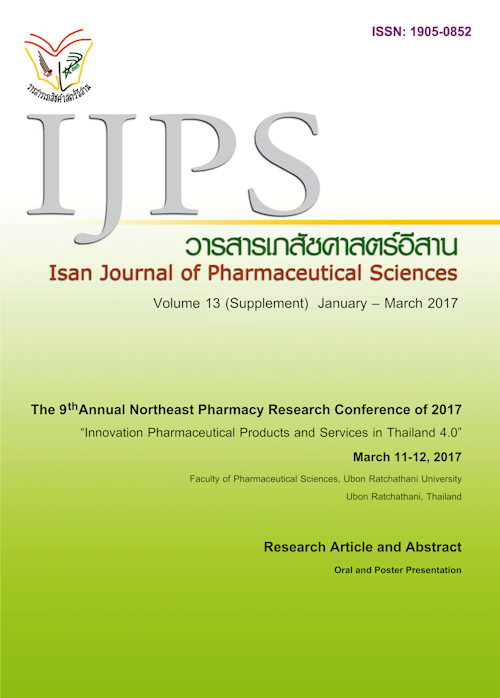Development and Characterization of Curcuma comosa Extract Loaded Nanostructured Lipid Carriers
Main Article Content
Abstract
Introduction: Curcuma comosa Roxb. has been used for treatment a wide range of women reproductive disorders in Thai folk medicine because it contains phytoestrogens. Currently, it has been studied several bioactives. However, the extract has been reported the low bioavailability with some adverse effects by oral administration. Nanostructured lipid carriers (NLC) is the delivery system compatible with the lipophilic extract. The objectives of this study were to optimize the NLC compositions and study their stabilities. Methods: NLC was developed and determined the particle size, polydispersity index (PDI), zeta potential (ZP), entrapment efficiency, loading capacity and thermal analysis. The obtained formulations were kept at 4, 25 and 40 ºC for 180 days, and then were investigated the particle characterization and drug quantity. Results: The optimized formulation contained 2.5 %w/w surfactant, 30 %w/w of liquid lipid in lipid phase and 7.5 %w/w lipid phase in formulation. The particle size, PDI, ZP and %EE of the blank and incorporated-NLC were 200 d 225 nm, 0.215 - 0.0270, -30 mV and over 90 % EE, respectively. The NLC showed amorphous property and good stability. Conclusion: Nanostructured lipid carriers is appropriate to encapsulate C. comosa extract with small particle size and good stability.
Article Details
In the case that some parts are used by others The author must Confirm that obtaining permission to use some of the original authors. And must attach evidence That the permission has been included
References
Gunullu U, Uner M, Yener G, et al. Formulation and characterization of solid lipid nanoparticles, nanostructured lipid carriers and nanoemulsion of lornoxicam for transdermal delivery. Acta Pharm 2015, 65: 1-13.
Jantaratnotai N, Utaisincharoen P, Piyachaturawat P, et al. Inhibitory effect of Curcuma comosa on NO production and cytokine expression in LPS-activated microglia. Life Sci 2006, 78: 571-577.
Janyaprasert V B, Teeranachaideekul V, Souto E B, et al. Q10 dloaded NLC versus nanoemulsions: Stability, rheology and in vitro skin permeation. Int J Pharm 2009, 377: 207-214.
Hallstar. Oliwax [Online]. 2014 May 19 [cited 2014 Oct 27]. Available from: https://www.hallstar.com/product/oliwax/
Khurana S, Jain N K, and Bedi P M S. Development and characterization of a novel controlled release drug delivery system based on nanostructured lipid carriers gel for meloxicam. Life Sci 2013, 93: 763-772.
Pardeike J, Hommoss A, and Muller R H. Lipid nanoparticles (SLN, NLC) in cosmetic and pharmaceutical dermal products. Int J Pharm 2009, 366: 170-184.
Suksiriworapong J, Rungvimolsin T, A-gomol A, et al. Development and Characterization of Lyophilized Diazepam-Loaded Polymeric Micelles. AAPS Pharm Sci Tech. 2014, 15(1): 52-64.
Siekmann B, and Westesen P. Thermoanalysis of the recrystallization process of melt-homogenized glyceride nanoparticles. Colloids Surf B 1994, 3: 159-175.
Su J, Sripanidkulchai K, Hu Y, et al. Increase in situintestinal absorption of phytoestrogenic diarylheptanoids from Curcuma comosa in nanoemulsion. AAPS Pharm Sci Tech 2013, 14(3): 1055-1062.
Suksamrarn A, Ponglikitmongkol M, Wongkrajang K, et al. Diarylheptanoids, new phytoestrogens from the rhizomes of Curcuma comosa: Isolation, chemical modification and estrogenic activity evaluation. Bioorg Med Chem 2008, 16: 6891-6902.
Tantiyasawasdikul S, Limpongsa E, Jaipakdee N, and Sripanidkulchai B. Effects of vehicles and enhancers on the skin permeation of phytoestrogenic diarylheptanoids from Curcuma comosa. AAPS Pharm Sci Tech 2016, doi:10.1208/s12249-016-0582-3.
Winutthayanon W, Piyachaturawat P, Suksamrarn A, et al. Diarylheptanoids phytoestrogens isolated from the medicinal plant Curcuma comosa: Biologic action in vitro and in vivo indicate estrogen receptor-dependent mechanisms. Environ Health Perspect 2009; 117: 1155-1161.
Ying-ngam B, Phimpanit Y, Wongkasemchai N, et al. Encapsulation of rice bran oil in solid lipid nanoparticles (SLN) for skin hydration and viscoelasticity. IJPS 2007; 3(2): 8-22.

